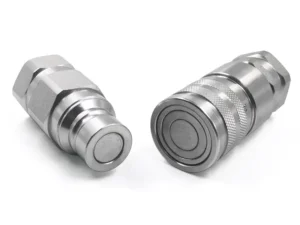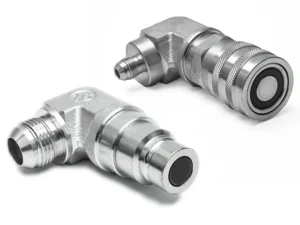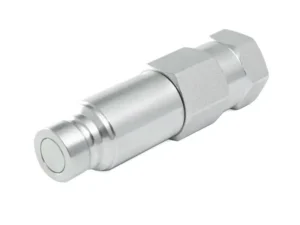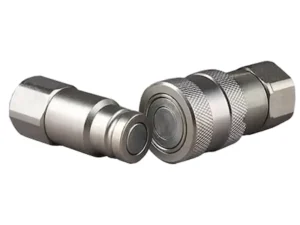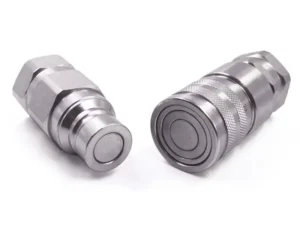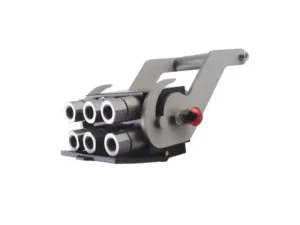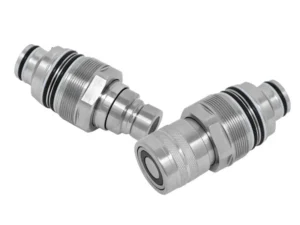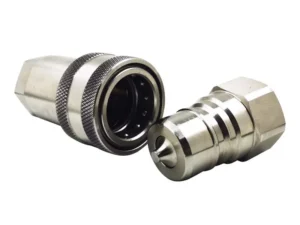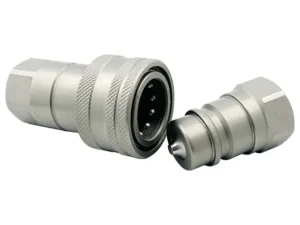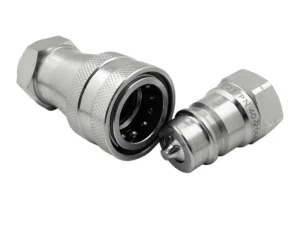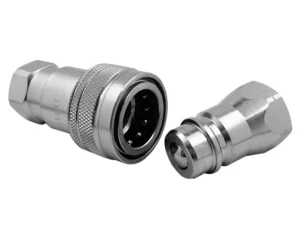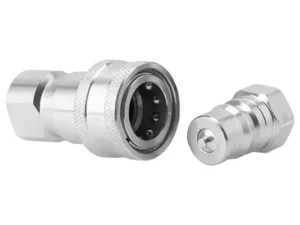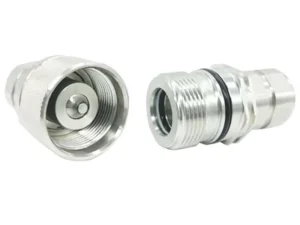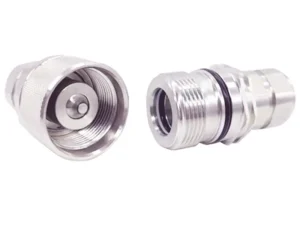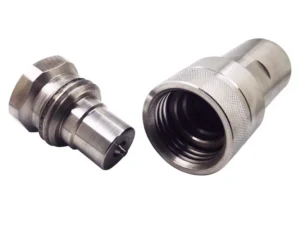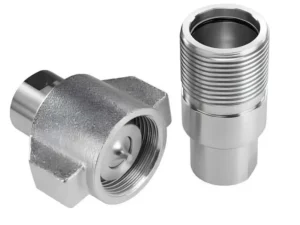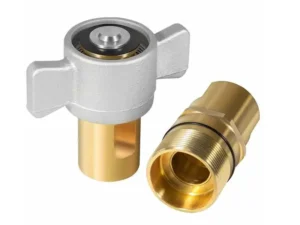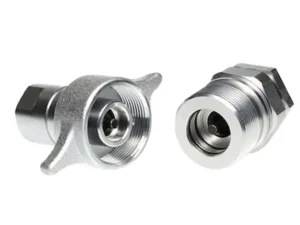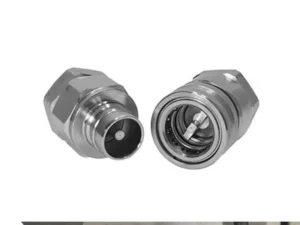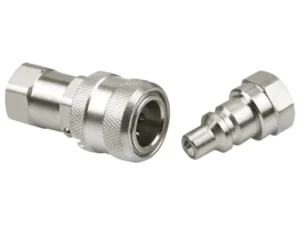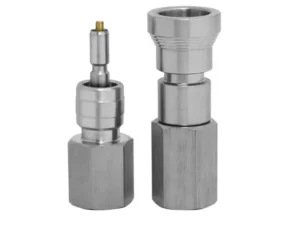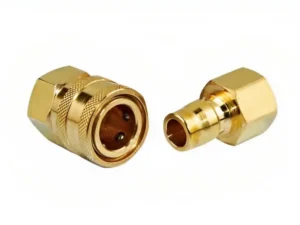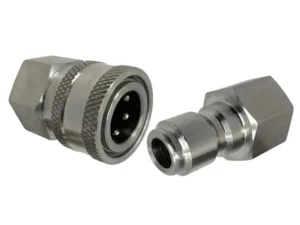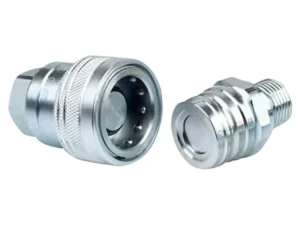Frequently Asked Questions
Questions About Products
Hydraulic Quick Couplings: Connecting Power with Speed and Ease
Hydraulic quick couplings are specialized connectors designed for rapidly and easily connecting and disconnecting hydraulic lines without tools or complicated procedures. They play a crucial role in various industries that rely on hydraulic power, from construction and agriculture to manufacturing and mining.
Function
- They typically consist of two halves: a male and a female connector.
- Each half features a locking mechanism that engages or disengages with a simple lever or push-button mechanism.
- When connected, the couplings create a leak-proof seal, allowing hydraulic fluid to flow freely between the lines.
- Disconnecting is equally quick and straightforward, often without needing to shut down the system or bleed air.
Benefits
- Increased Efficiency: They save time and effort compared to traditional threaded connections, improving productivity and equipment uptime.
- Reduced Spill Risk: Quick connections minimize the risk of spills and leaks, enhancing safety and environmental protection.
- Improved Maintainability: Easy disconnect and reconnect simplify maintenance tasks and repairs.
- Versatility: A wide range of designs and sizes caters to various pressure ratings, flow requirements, and application types.
Applications
- Construction equipment: Connecting hydraulic lines on excavators, loaders, and other machinery.
- Agricultural machinery: Attaching implements like plows, mowers, and balers to tractors.
- Manufacturing processes: Connecting hydraulic tools, presses, and other equipment.
- Mobile hydraulics: Coupling lines on trucks, trailers, and other mobile equipment.
- Wind turbines: Connecting hydraulic systems for blade pitch control and maintenance.
quick coupling designed to meet the international standards set by the International Organization for Standardization (ISO). These standards ensure compatibility and interchangeability between different manufacturers and guarantee a certain level of performance and safety.
Key Features of ISO Standard
- Dimensional consistency: They adhere to precise internal and external dimensions, ensuring proper fit and connection with other ISO-compliant couplings, regardless of the manufacturer.
- Performance specifications: They meet specific pressure, flow, and temperature ratings, guaranteeing reliable operation under demanding conditions.
- Interchangeability: Different series within the ISO standard (e.g., ISO 7241 Series A and B) are often interchangeable, providing flexibility and convenience for users.
- Safety features: Many ISO couplings incorporate built-in safety mechanisms like sleeve locks or double shutoff valves to prevent accidental disconnection or fluid leakage.
- Quality assurance: Adherence to ISO standards often indicates a higher level of manufacturing quality and reliability.
Popular ISO Series:
- ISO 7241 (A Series and B Series): General-purpose couplings for medium pressure applications (up to 5000 psi).
- ISO 5675: additional requirements based on ISO 7241 Series A, special for Agricultural and forest equipement application, only 1/2″ and 3/4″ size, in the marketing usually 1/2″.
- ISO 14540: high pressure, screw to connect quick coupling, widely used in high pressure ( 10000PSI) hydraulic tools.
Choosing the right quick couplings for your needs requires careful consideration of several factors to ensure they function safely, efficiently, and reliably within your specific application.
Function and Application
- Identify the fluid: What fluid will be passing through the coupling? Consider compatibility with the coupling materials and potential corrosion risks.
- Pressure and Temperature: Determine the maximum operating pressure and temperature your system will encounter. Choose couplings with ratings exceeding these values for a safety buffer.
- Frequency of Connection: Will you be connecting and disconnecting frequently? Some couplings are faster and easier to use than others.
- Application type: Consider factors like vibration, dust, chemical exposure, and space constraints to choose an appropriate design and material.
Coupling Design and Features
- Type: Push to connect, ball locked, flat face, push-pull, camlock etc.
- Body Material: Materials like brass, stainless steel, or special alloys offer varying levels of durability, corrosion resistance, and weight.
- Seal Material: Seal compatibility with the fluid and pressure rating is crucial. Common options include NBR, FKM, PTFE etc.
- End Connections: Select the compatible end connections (threaded, flanged, etc.) for your piping system.
- Safety Features: Look for features like leakproof seals, automatic shutoff valves, and pressure relief mechanisms.
- Ease of Use: Choose couplings that are easy to connect and disconnect, considering operator accessibility and potential limitations.
- Cost: Consider the initial cost of the couplings as well as any ongoing maintenance or replacement expenses.
The working pressure of a quick coupling is a critical specification that determines its suitability for your specific application. It refers to the maximum continuous pressure the coupling can safely withstand without compromising its integrity or leading to leaks.
- Always ensure the working pressure of the quick coupling exceeds the maximum operating pressure of your system by a safety margin. This buffer accounts for potential pressure spikes, fluctuations, and unforeseen circumstances.
- Choosing a coupling with a significantly higher pressure rating than necessary can be unnecessarily expensive and bulky.
- Refer to the manufacturer’s specifications or technical data sheet for the specific working pressure rating of the quick coupling you’re considering.
Quick couplings can be divided into several categories, the ball lock type usually conforms to ISO7241 and can be divided into series A and series B. Flat face quick couplings often conform to ISO16028, and threaded high-pressure quick couplings have ISO14540 and ISO14541. After knowing their standards, you can measure the diameter of the male connector and determine the body of the quick release coupling according to the ISO standard size requirements. The body size of the quick coupling can be determined by measuring the diameter of the male coupler.
Most quick couplings use seal rings to achieve a sealing effect. When a quick coupling is disconnected, there are usually valves on both the male coupler and female coupler ends to block fluid leakage. Usually, Poppet valves and flat face valves use a deformation of the seal ring to squeeze and achieve a seal. The ball valve does not need to use a seal ring, but it uses the deformation between the steel ball and the housing to achieve a seal. Because of the different fluid materials and operating temperatures, the seal material is very important for the selection of quick couplings in different environments. Choosing the wrong seal ring material can cause leaks or even accidents during using the quick couplings. Most quick couplings are used in hydraulic equipment, so the fluid is often hydraulic oil. Therefore, the default seal ring of most quick couplings is NBR, and the working temperature is generally recommended to be below 100˚C. When higher operating temperatures are required, we use FKM, and FFKM is often used in chemical fluids. If your application environment of quick coupling is special, please consult us first when you purchase quick coupling.
In many cases, customers need custom quick couplings for their projects. Equipment manufacturers, for example, will customize quick couplings for their own equipment to differentiate themselves from other manufacturers. Sometimes some assembly dimensions of quick couplings need to be specially designed to fit with other accessories for installation. Or for newly designed hydraulic systems, hydraulic pipe connections, etc.
Regardless of how you need to customize your quick coupling, it is always best to have the connection dimensions of the quick coupling conform to ISO standards at the beginning of the design process. This will make it easy for the user to purchase replacement parts on the market during the subsequent service of the product. Make the product last longer. If there is a similar competitor’s design, you can send us the sample, through communication, we help you to update and improve the design according to your needs.
To custom a quick coupling, you need to think about the questions
where the quick coupling use
the temperature they working
the pressure they working
the burst pressure
the fluid material
the seal ring material
the dimensions for other elements
please contact us for more info
Questions About Payments and Delivery(buy on web store)
We offer a secure and convenient checkout experience with a variety of payment methods to choose from, including credit cards, debit cards, and PayPal. We also accept international payments and use the latest security measures to protect your information.
Supported payment methods
PayPal can save the following payment methods to the vault:
- Credit and debit cards (Visa, Mastercard, Discover, American Express)
- PayPal Wallets
- Venmo
When you purchase a product on our website, we ship the product via express delivery or ship it from our Amazon warehouse in the United States.
Our products provide a certain warranty period. Normally, quick connectors will provide a one-year warranty. For some applications, we provide a 6-month warranty.
Product registration is required to provide evidence of warranty. When customers scan the QR code, they can jump to the product registration page and simply fill in some information, so that we can provide better after-sales service. Product warranty included.
